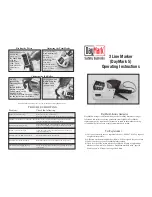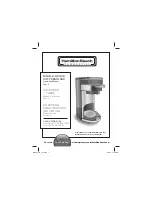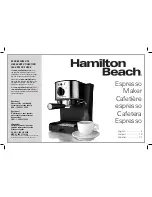
20
N
Ne
ee
ed
d h
he
ellp
p??
Q
Qu
ue
es
sttiio
on
ns
s a
ab
bo
ou
utt g
ge
en
ne
erra
all
p
pe
errffo
orrm
ma
an
nc
ce
e a
an
nd
d o
op
pe
erra
attiio
on
n
Question 1
How do I make doughnuts with my
breadmaker?
How does it make the hole?
The breadmaker only makes the dough for the
doughnuts. You must form and fry the doughnuts in a
conventional deep fryer.
Question 2
What should I do if the kneading blade
comes out with the bread?
Remove it with a pair of plastic tongs before slicing
the bread. Since the blade can be disconnected from the
pan, it is not a malfunction if it comes out in your bread.
Question 3
Why does my bread sometimes have some
flour on the side crust?
In some cases, the flour mix may remain on the
corners of the baking pan. When this happens, it
usually can be eaten or simply trim off that portion of
the outer crust with a sharp knife.
Question 4
Why isn't the dough mixing? I can hear the
motor running.
The Kneading Blade or baking pan may not be
inserted properly. Make sure the pan is facing the right
way and that it has ‘clicked’ and seated into the
bottom of the breadmaker.
Question 5
How long does it take to make bread?
Timings for each setting are outlined on page 7.
Question 6
Why can't I use the timer when baking
with fresh milk?
The milk will spoil if left sitting in the machine too
long. Fresh ingredients such as eggs and milk should
never be used with the delayed timer feature.
Question 7
Why do I have to add the ingredients in a
certain order?
This allows the breadmaker to mix the ingredients
in the most efficient manner possible. It also serves to
keep the yeast from combining with the liquid before
the dough is mixed.
Question 8
When setting the timer for morning, why
does the machine make sounds late at night?
The machine must start operation several hours
before the bread will be ready. These sounds are made
by the motor when kneading the dough. It is a normal
operation, not a malfunction.
Question 9
The kneading blade is stuck in the bread
pan. After baking how do I get it out?
The kneading blade may ‘stick’ in place after
baking. Running warm or hot water over the blade
should loosen it enough to be removed. If still stuck,
soak in hot water for about 30 minutes.
Question 10
Can I wash the baking pan in the
dishwasher?
No. The baking pan and kneading blade must be
washed by hand.
Question 11
What will happen if I leave the finished
bread in the baking pan?
Whilst still in the breadmaker for the first hour
after baking is complete the bread ’keeps warm’ to
prevent it becoming ‘soggy’.
It may result in a ‘soggy’ loaf of bread as excess
steam (moisture) would not be able to escape. Allow
to cool on a wire rack after baking to prevent this.
Question 12
Why did the dough only partially mix?
Why didn't it mix completely?
The batter may be too heavy or dry. Also, the
kneading blade or baking pan may not be inserted
properly. Ingredients may have been added in the
wrong order.
Question 13
Why didn't the bread rise?
The yeast could be bad, past it’s sell by date or
possibly no yeast was added at all. Also, if the mixing
was not complete, rising problems could develop.
Gluten free flour will also affect the amount of rising.
Question 14
Why can't the delayed finish be set for
more than 12 hours? What is the minimum
time a cycle may be delayed?
The maximum length of delay is 12 hours plus the
particular cycle time. For example, setting 3 has a cycle
that takes 3:25 hours, so it may be delayed up to 15.25
hours. The minimum length of delay for each setting is
10 minutes, as the delay clock increases in 10 minute
increments.





































